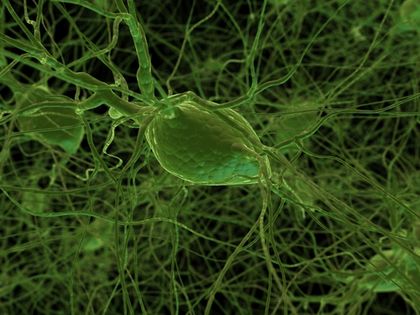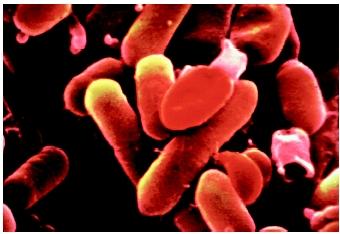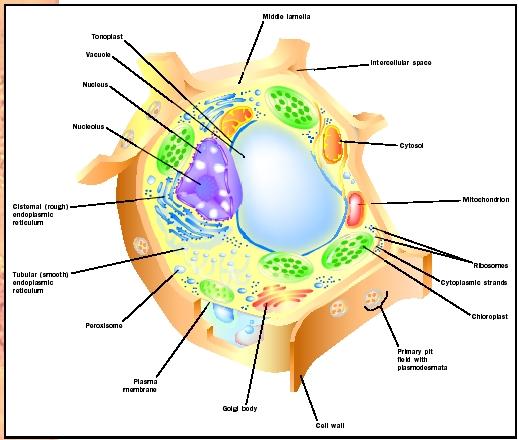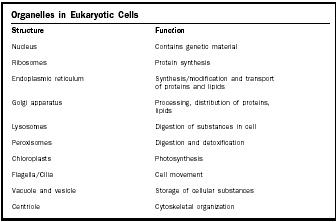Cell

A cell is the smallest unit of living matter. Cells were first identified in Europe in the seventeenth century by Antoni van Leeuwenhoek and others. They were named by Robert Hooke, an Englishman, who said they reminded him of the rooms or "cells" in a monastery. The cell theory describes some fundamental characteristics of all cells and is one of the unifying concepts in biology. It states that: (1) all organisms are made of cells, a cell is the structural and functional unit of organs, and therefore cells are organisms; and (2) cells are capable of self-reproduction and come only from preexisting cells.
Prokaryotic Cells
Cells come in many shapes and sizes and have different structural features. Bacteria are single-celled organisms approximately 1 to 10 micrometers (.00004 to .0004 inch) in size and can be spherical, rod-shaped, or spiral-shaped. They are known as prokaryotes (from the Greek pro, meaning "before" and karyon, meaning "kernel" or "nucleus") because they contain a nucleoid region rather than a true nucleus where their genetic material is found. All bacteria have cell walls that may be surrounded by a capsule and/or a gelatinous slime layer.
Beneath the cell wall is the plasma membrane responsible for regulating the flow of materials into and out of the cell's cytoplasm within the interior of the cell. The cytoplasm is composed of fluid known as cytosol and solid materials. Within the cytosol are ribosomes , granular bodies that direct


Eukaryotic Cells
Eukaryotic cells (from the Greek eu, meaning "true" and karyon, meaning "kernel" or "nucleus") are more complex than prokaryotic cells and are found in both unicellular organisms like the amoeba and multicellular organisms like sunflowers, mushrooms, and humans. They are generally larger than prokaryotic cells, ranging from about 10 to 100 micrometers (.0004 to .004 inch) in size. In multicellular organisms, there are many different types of cells that perform specialized functions. In animals, for instance, pancreatic cells make and secrete hormones , whereas red blood cells are specialized for transporting oxygen throughout the body. Cells with specialized functions such as these are called "differentiated."
All eukaryotic cells share specific structural characteristics. These include a true nucleus that is bounded by a double-layered membrane known as the nuclear membrane. Within the nucleus is housed the cell's genetic material in the form of linear chromosomes of DNA contained in thread-like structures called chromatin . All eukaryotic cells have a plasma membrane that encloses the cytoplasm. Cells of plants, fungi, and many protists have an additional outer boundary called a cell wall that differs significantly in structure and composition from that of a prokaryotic cell.
Eukaryotic cells have many different kinds of small membrane-bound structures called organelles that, with the exception of ribosomes, are absent from prokaryotic cells. Eukaryotic ribosomes (which are not enclosed by a membrane) float freely in the cytosol or are attached to another organelle known as the endoplasmic reticulum (ER). The ER is a series of membrane-bound, fluid-filled spaces in contact with the nuclear membrane. Its function is to synthesize and/or modify proteins, phospholipids, and cholesterol and to transport substances from the nucleus to the rest of the cell.
When the ER is studded with ribosomes it is called the rough ER. When ribosomes are absent it is called the smooth ER. The Golgi apparatus is a system of membrane-enclosed sacs responsible for transporting newly synthesized proteins and lipids from the ER to other organelles and the plasma membrane. It is also the site of polysaccharide synthesis and modification of proteins and lipids by addition of sugars.
Both animal and plant cells have mitochondria , power houses that convert energy stored in the chemical bonds of nutrients like carbohydrates , proteins, and fats into adenosine triphosphate (ATP), a high-energy chemical compound that is required for many cellular processes. Many plant cells also have chloroplasts, organelles that contain the pigment chlorophyll. Chloroplasts conduct photosynthesis, in which plants use sunlight, water, and carbon dioxide to synthesize the sugar glucose .

| Organelles in Eukaryotic Cells | |
| Structure | Function |
| Nucleus | Contains genetic material |
| Ribosomes | Protein synthesis |
| Endoplasmic reticulum | Synthesis/modification and transport of proteins and lipids |
| Golgi apparatus | Processing, distribution of proteins, lipids |
| Lysosomes | Digestion of substances in cell |
| Peroxisomes | Digestion and detoxification |
| Chloroplasts | Photosynthesis |
| Flagella/Cilia | Cell movement |
| Vacuole and vesicle | Storage of cellular substances |
| Centriole | Cytoskeletal organization |
Lysosomes are membrane-enclosed bodies in plant and animal cells that contain enzymes responsible for digesting substances within the cell. In animal cells, peroxisomes contain enzymes that metabolize lipids and alcohol. In plants, peroxisomes also convert fatty acids into molecules that are precursors of sugars. Both plant and animal cells have vacuoles, membranous sacs that store substances such as water, sugars, and salts. Protozoans, a type of unicellular protist, have specialized contractile vacuoles for removing excess water from the cell.
Most organelles do not flow freely in the cytoplasm but are anchored to a complex intracellular framework known as the cytoskeleton , which is made of three different types of protein fibers: microfilaments, intermediate filaments, and microtubules. The cytoskeleton is involved in maintaining cell shape and participates in cell movement and cell division. The centrosome contains a pair of organelles called centrioles close to the nucleus of animal cells. It is responsible for organizing some of the cytoskeletal components.
Some plant and animal cells have projections from the plasma membrane known as flagella or cilia that are capable of movement. For example, a single flagellum is responsible for the movement of sperm cells.
SEE ALSO Cell Wall ; Chloroplast ; Cytoskeleton ; DNA ; Golgi ; History of Biology: Cell Theory and Cell Structure ; Mitochondrion ; Nucleus ; Ribosome ; Vacuole
Michele D. Blum
Bibliography
Mader, Sylvia S. Biology, 6th ed. Boston: McGraw-Hill, 1998.
McFadden, Carol, H., and William T. Keeton. Biology: An Exploration of Life. New York: W. W. Norton and Company, Inc., 1995.
1.why size of animal cell is small than plan cell?
2.is it size of animal and plant does affect the size of the animal or plant cells?
hope you can email me your answer.